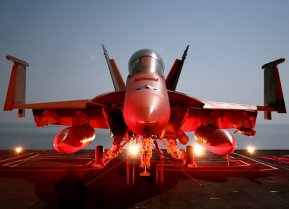The U.S. Military's Stealth Sixth-Generation Fighter: Flying by 2029?
As of now, it’s a race between the Air Force and the Navy.
Though the United States’ F-22 and F-35 fighters are arguably the world’s premier stealth aircraft, they may be outclassed before the end of the decade. What would replace them? A sixth-generation fighter.
The U.S. Navy is in the process of developing a fighter, now tentatively knowns as the F/A-XX, which would replace some of their airframes, like the F/A-18E/F Super Hornet, and work alongside the newer F-35 stealth fighter. Though what the fighter would look like exactly is not known for certain, it is believed that it would have a tailless airframe design, somewhat reminiscent of the Air Force’s B-2 and B-21 stealth bombers.
The Air Force also has a sixth-generation fighter, dubbed Next Generation Air Dominance, in the works, a project that has actually made at least one test flight as of late last year. The former Assistant Secretary of the Air Force Will Roper outlined how far the flying branch had gone in testing their new airframe, saying “We’ve already built and flown a full-scale flight demonstrator in the real world, and we broke records in doing it.” The Air Force initiative may also feature a tailless design, as well as have the ability to fly without a pilot.
And, a recent contract announcement by the Department of Defense may have subtly announced a timeline for introducing one or both of the sixth-generation aircraft.
The Department of Defense contract award notice reads as follows:
“Raytheon Missile Systems, Tucson, Arizona, has been awarded a $74,000,000 indefinite-delivery/indefinite-quantity contract (FA8675-21-D-0002) for Advanced Medium-Range Air-to-Air Missile (AMRAAM) aircraft integration support.” Though this does not necessarily provide any clues directly related to the sixth-generation fighter, the following does. “This contract will provide the necessary aircraft lab, flight test, flight clearance and simulation support during all integration requirements in AMRAAM for F-15, F-16, FA-18, F-22, F-35 and other current inventory,” including next-generation platforms that may be added to the Air Force or Navy inventory prior to the end of fiscal year 2029.
The two sixth-generation fighter jet programs in the United States may be prompting China to move forward with its own sixth-generation fighter as well. Currently, China’s premier stealth fighter is the J-20, a twin-engine stealth fighter whose development and introduction into PLA service was relatively smooth, thanks in large part to leaning on design features found in its F-22 rival.
Still, the J-20 platform has struggled, in large part due to underpowered domestically-designed engines, forcing the stealth fighter to rely on more powerful Russian-derivative powerplants. Some American commentators have speculated that Beijing’s engine troubles could continue to plague new aircraft development, casting doubt on the combat effectiveness of a truly home-grown Chinese sixth-generation fighter.
Regardless of any foreign initiatives, the United States was the first to field a fifth-generation fighter jet and may be the first to have a sixth-generation fighter in service as well.
Caleb Larson is a Defense Writer with The National Interest. He holds a Master of Public Policy and covers U.S. and Russian security, European defense issues, and German politics and culture.
Image: Reuters

